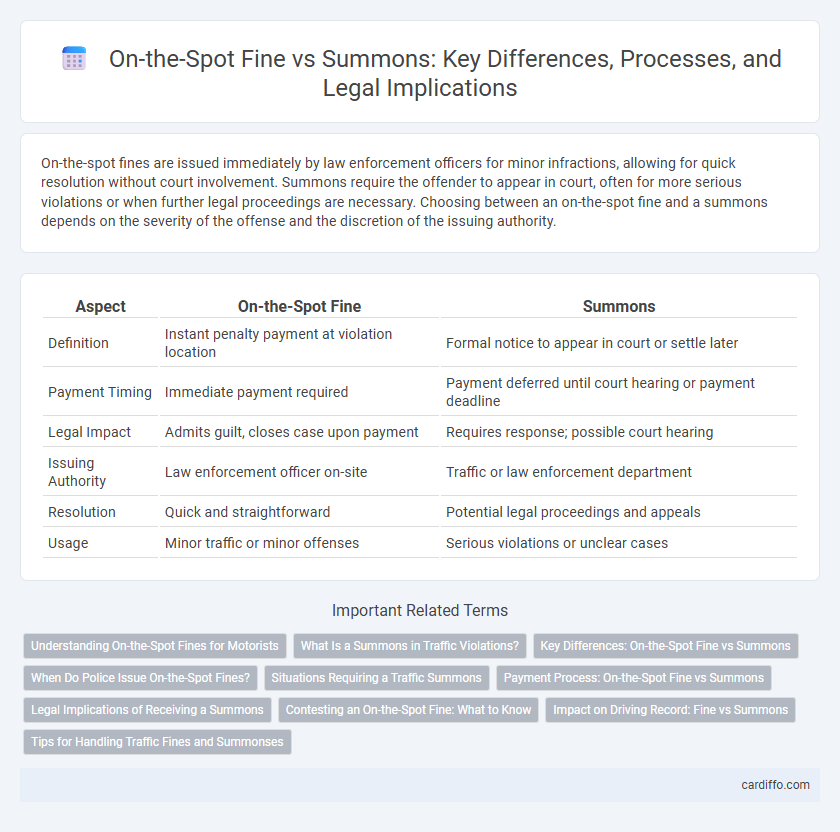On-the-spot fines are issued immediately by law enforcement officers for minor infractions, allowing for quick resolution without court involvement. Summons require the offender to appear in court, often for more serious violations or when further legal proceedings are necessary. Choosing between an on-the-spot fine and a summons depends on the severity of the offense and the discretion of the issuing authority.
Table of Comparison
| Aspect | On-the-Spot Fine | Summons |
|---|---|---|
| Definition | Instant penalty payment at violation location | Formal notice to appear in court or settle later |
| Payment Timing | Immediate payment required | Payment deferred until court hearing or payment deadline |
| Legal Impact | Admits guilt, closes case upon payment | Requires response; possible court hearing |
| Issuing Authority | Law enforcement officer on-site | Traffic or law enforcement department |
| Resolution | Quick and straightforward | Potential legal proceedings and appeals |
| Usage | Minor traffic or minor offenses | Serious violations or unclear cases |
Understanding On-the-Spot Fines for Motorists
On-the-spot fines provide immediate penalties to motorists for traffic violations such as speeding or illegal parking, allowing authorities to enforce rules promptly. These fines are typically paid immediately or within a short period, offering a faster resolution than summons, which involves a court appearance. Understanding the procedures and consequences of on-the-spot fines helps motorists avoid further legal complications and additional penalties.
What Is a Summons in Traffic Violations?
A summons in traffic violations is an official legal document issued by law enforcement requiring the recipient to appear in court to address the alleged offense. Unlike on-the-spot fines, which demand immediate payment, a summons initiates a formal judicial process that may involve hearings and potential penalties determined by a judge. Common traffic violations leading to a summons include reckless driving, DUI, and failure to appear for previous violations.
Key Differences: On-the-Spot Fine vs Summons
On-the-Spot Fine requires immediate payment at the scene, ensuring quick resolution without court involvement, whereas a Summons mandates a court appearance to contest or pay the penalty later. On-the-Spot Fines typically apply to minor infractions, allowing law enforcement to enforce regulations efficiently, while Summons are issued for more serious violations needing judicial consideration. Understanding these key differences aids in timely responding to fines and avoiding additional legal consequences.
When Do Police Issue On-the-Spot Fines?
Police issue on-the-spot fines during routine traffic stops or minor infractions where the violation is clear and can be immediately confirmed by the officer. These fines are commonly given for offenses such as speeding, illegal parking, or failing to wear a seatbelt. The immediate payment option streamlines the enforcement process by reducing administrative burdens and allowing quicker resolution of minor offenses.
Situations Requiring a Traffic Summons
Situations requiring a traffic summons typically involve serious violations such as reckless driving, DUI offenses, or cases where the driver refuses to provide identification or comply with law enforcement. A summons is issued when the infraction demands a court appearance rather than immediate payment, ensuring legal proceedings address the gravity of the offense. This legal approach helps maintain road safety by holding offenders accountable through formal judicial review.
Payment Process: On-the-Spot Fine vs Summons
On-the-spot fines require immediate payment at the violation location or within a designated short time frame, often allowing payment via cash, card, or mobile apps. Summons payments involve receiving a formal notice with a specified deadline, typically requiring payment through mail, online portals, or in-person at service centers. The convenience and immediacy of on-the-spot fines contrast with the more formal, sometimes lengthy procedures associated with summons payments.
Legal Implications of Receiving a Summons
Receiving a summons carries significant legal implications, requiring the recipient to appear in court on a specified date to respond to allegations. Failure to comply with a summons can lead to additional penalties, including fines, arrest warrants, or default judgments. Unlike on-the-spot fines, summonses initiate formal legal proceedings that may impact one's criminal record or insurance rates.
Contesting an On-the-Spot Fine: What to Know
Contesting an on-the-spot fine requires understanding the specific procedures set by local traffic authorities, including the deadline for submitting an appeal and the necessary documentation such as evidence or witness statements. It's essential to clearly present your case, often through a written explanation or during a formal hearing, to demonstrate why the fine is unjustified or incorrect. Failure to contest within the stipulated timeframe may result in the fine becoming final, emphasizing the importance of prompt action.
Impact on Driving Record: Fine vs Summons
An on-the-spot fine typically results in an immediate payment requirement without necessarily impacting the driving record, depending on the jurisdiction and severity of the offense. In contrast, a summons often leads to a court appearance where the outcome can result in points or marks added to the driving record, affecting insurance rates and license status. Understanding the differences in how fines versus summonses influence driving records is crucial for managing legal and financial consequences.
Tips for Handling Traffic Fines and Summonses
Promptly review the details of an on-the-spot fine or summons to ensure accuracy and legitimacy. Keep thorough records of all documents and payment receipts to avoid disputes or repeated fines. Seek legal advice if the fine or summons seems unjust or if you are unsure about contesting it in court.
On-the-Spot Fine vs Summons Infographic

 cardiffo.com
cardiffo.com